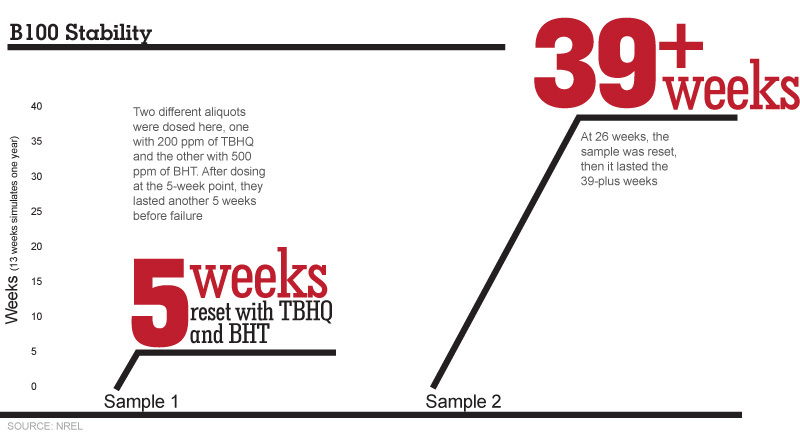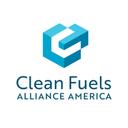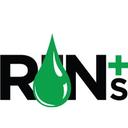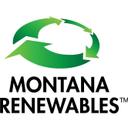Positive results from long-term stability study

March 12, 2013
BY Ron Kotrba
National Renewable Energy Laboratory chemist Earl Christensen presented preliminary results from an ongoing B100 and biodiesel blends stability study at the National Biodiesel Conference & Expo in Las Vegas Feb. 4-7. The study was commissioned to determine what it would take to store B100 and blends for one to three years. Two B100 samples were tested, both treated with antioxidant at the production site. Feedstocks were unknown. Thirteen weeks of aging simulates one year.
After five weeks, one sample dipped below 2.5 hours on Rancimat and two different aliquots were treated with 200 ppm of TBHQ and 500 ppm of BHT to “reset” them; they lasted another 5 weeks. The other sample lasted 26 weeks in an underground storage simulation (two years) with no further adulteration. After lasting 26 weeks, that same sample dipped to 2.5 hours on Rancimat and was reset with stabilizer. It was stable for another 13 weeks, “which was really surprising,” Christensen said.
New B100 samples were drawn for the blend tests. Two biodiesel samples were taken prior to additization by the producer. NREL dosed each with enough antioxidant to pass the three-hour and six-hour Rancimat tests, then each was blended at 20 percent with two different diesel fuels, hydrotreated and hydrocracked, to produce eight B20 samples. Christensen said NREL is only two-thirds through the 39-week test, and while the data is preliminary, it implies that almost every B20 sample remained on spec for Rancimat testing even after the simulated two years of underground storage. Two of the eight B20 samples were off spec for Rancimat but Christensen said those were blended with B100 dosed to pass the three-hour test, and they were blended in two different diesel fuels. The two samples that failed Rancimat could be treated with antioxidant to reset the fuels. “Essentially after two years, almost every B20 sample is still an on-spec fuel,” he said. Eight B5 samples under the same conditions were tested, and every one of those has remained on spec for the two simulated years.
Advertisement
Advertisement
Related Stories
Clean Fuels Alliance America on June 10 announced the launch of the newly redesigned BQ-9000 website, delivering a streamlined and user-friendly experience that better showcases the value of biodiesel quality assurance.
The U.S. EPA on Aug. 21 released data indicating nearly 2.04 billion RINs were generated under the RFS in August, up from 1.84 billion generated in August 2022. Total RIN generation for the first eight months of the year reached nearly 15.45 billion.
WestJet Group CEO Alexis von Hoensbroech, on Sept. 19 at the World Petroleum Congress in Calgary, addressed the airline's ambitions to achieve net-zero emissions by 2050 and the vital role SAF plays in the future of decarbonizing aviation.
Clean Fuels Alliance America, American Soybean Association, National Oilseed Processors Association the U.S. Canola Association are urging the Biden administration to adopt GREET for the purposes measuring GHG reductions for the SAF tax credit.
Montana Renewables LLC, a subsidiary of Calumet Specialty Products Partners LP, on Sept. 18 hosted an event to celebrate the first receipts of camelina oil into its biorefinery in Great Falls, Montana. The facility produces renewable diesel and SAF.
Upcoming Events










